Home » Wind Energy » How About the Facts Regarding Wind Energy?
How About the Facts Regarding Wind Energy?
Introduction
Wind energy, used by civilizations for thousands of years to grind grain and pump water using windmills, was reborn during the energy crisis of the 1970s when improvements in materials and technology made wind turbines more common. Today, windgenerated electricity is helping to provide for U.S. electrical needs.
Wind is created when solar energy heats the atmosphere. This heat produces differences in air pressure as cold air is denser than warm air. Air is made of gases and gases will naturally move from an area of high concentration to an area of low concentration to equalize pressure differences (reaching an equilibrium), creating wind as a result. In the process, energy from the sun is converted into kinetic energy (the energy in motion).
The output of a wind energy system is measured in kilowatts (1,000 watts) or megawatts (1,000,000 watts). Energy is power used over time and is calculated by multiplying power and time. Wind-generated electricity is measured in kilowatt-hours, a unit of energy. One kilowatt-hour of electrical energy equals 3,413 Btu (British thermal units).
Wind Potential
Wind resources are plentiful in the United States. With average, reliable wind speeds of 15 miles per hour or more, states in and around the Great Plains area of the United States possess the nation’s greatest wind potential.
The best sites for wind potential in Wisconsin are found along Lake Michigan and Superior, where average wind speeds may reach 14 miles per hour (see Estimated Wind Power Energy Potential (at 70 meters) and Existing Wind Development Locations, 2015). It is estimated that Wisconsin has an annual energy potential of 58 billion kilowatt hours, and it currently ranks 18th of the top 20 states for wind energy potential.
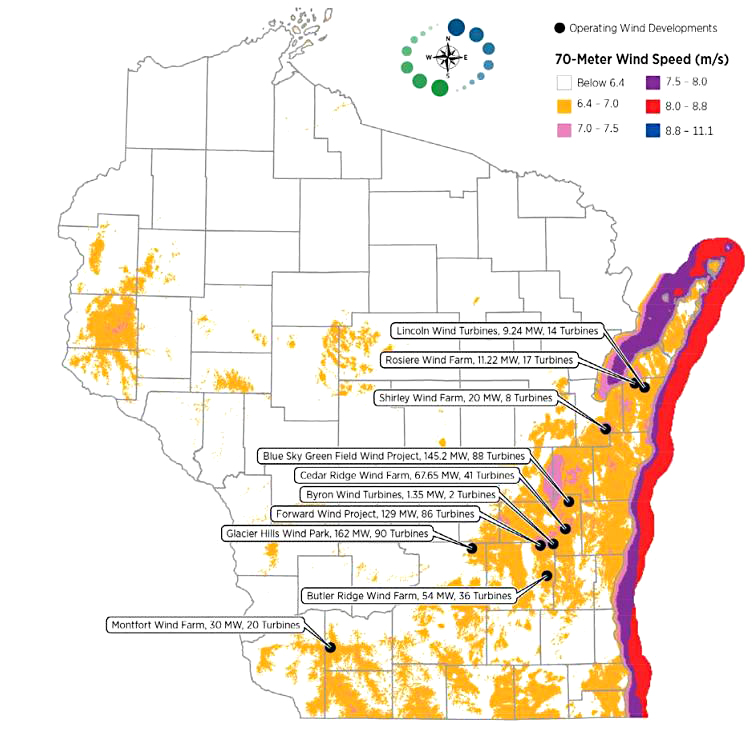
Electricity Produced Using Wind
The energy in wind is converted into electricity using wind turbines. A wind turbine is made up of an electrical generator mounted on a tower and connected to a propeller. The wind turns the blades of the propeller, causing the generator to spin and produced electricity. Rotor diameter and general sizes of turbines have increased and changed due to higher efficiency and more advanced technology (see Average turbine nameplate capacity, rotor diameter, and hub height installed during period).
Wind turbines can be used to provide electricity to single family homes, especially in rural areas. The electricity produced can be stored in batteries for use when wind speeds are low or when high winds could damage the turbine.
Electric utilities use larger wind turbines. Often the utility will place many wind turbines together in what is called a wind farm. The largest wind farm in the world is Gansu Wind Farm in China. Although it is not fully developed at this time, it had 10.73 GW installed at the end of 2014.
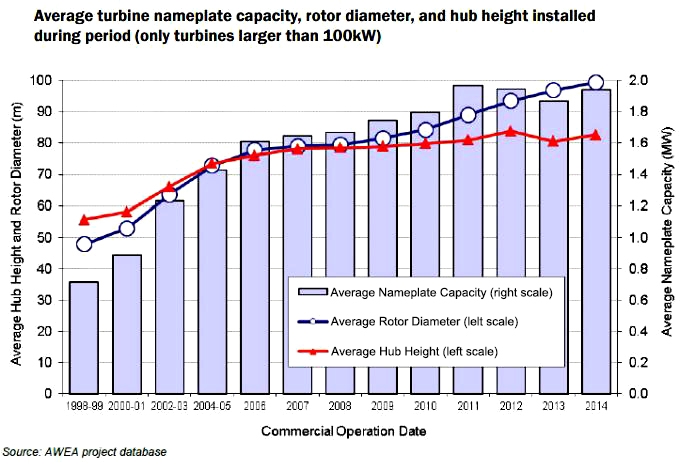
Wind Electricity Production
Wind power supplies nearly five percent of our nation’s electricity demand across 39 states. Worldwide, there are more than 268,000 wind turbines spinning to produce electricity. In 2014 installed wind capacity in Wisconsin was 648 MW with 417 turbines operating in utilities. Wind electricity production accounted for 2.5 percent of all in-state electricity production, enough to power 150,000 homes.
Other Uses
A modern wind turbine gets its design from windmills. Although windmills are not used as commonly anymore, they are still seen in rural parts of the U.S. and developing world to pump water or grind grain. A windmill is a device that has propeller blades connected to an axle with gears. The gears are connected to a vertical shaft that runs down the length of the tower and is connected to other mechanical equipment.
Effects
Wind energy has many benefits (see Wind generation in 2013 provided a range of environmental benefits). Wind turbines have no fuel costs and low operating and maintenance costs. They produce virtually no air emissions or waste while in use. For example, the amount of electricity generated by the wind in one year in California avoided the production of 16 million pounds of air pollutants and 2.7 billion pounds of greenhouse gases. The wind plants also saved the equivalent of 4.8 million barrels of oil. In addition, wind energy creates jobs, is a ‘homegrown’ energy source, diversifies the national energy portfolio, can provide income for farmers, and can be deployed in all regions of the U.S.
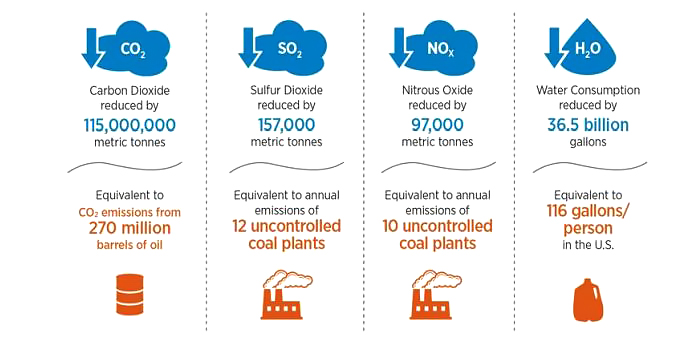
Wind generation in 2013 provided a range of environmental benefits
However, wind energy is unreliable because the wind does not blow steadily in most places. Therefore, the electricity produced by home wind turbines needs to be stored in batteries, or a backup generator must be available, which increases the total cost of a wind energy system. On the other hand, a wind farm is usually connected to a utility’s power lines, so other power plants can supply electricity when the wind is not blowing. Some concerns about wind farms are aesthetic problems, propeller noise, and interference with birds’ migratory patterns (although cell towers, electric lines, and domestic cats pose comparable threats to bird flight and populations). In addition, it is also important to assess the amount of waste and emissions produced by the manufacturing, transportation, and implementation processes of wind energy. Understanding these impacts and reducing environmental harms during the manufacturing processes will make wind energy even more appealing.
Outlook
After a lull, wind energy additions rebounded in 2014. Continued growth through 2017and beyond is expected and likely to become more mainstream. Texas continues to lead the nation in wind energy production, but other states such as Minnesota have implemented large-scale wind systems. Europe has aggressively developed wind power, and it has taken over hydropower as the third largest source of power generation in the EU. India, Brazil, China, Mexico, and Egypt also have sizable wind power projects underway.
Experts predict that by the year 2020 wind power could supply the U.S. with about 10 percent of the total electricity produced. No offshore wind energy plants are currently operating in the U.S. but progress is being made toward an offshore project in Rhode Island. The cost of wind-generated electricity has fallen and is becoming competitive with other ways of generating electricity. While wind energy is not expected to completely replace fossil- and nuclear-fueled electric power plants, its environmental advantages make it an attractive choice for the future.
Wind energy, used by civilizations for thousands of years to grind grain and pump water using windmills, was reborn during the energy crisis of the 1970s when improvements in materials and technology made wind turbines more common. Today, windgenerated electricity is helping to provide for U.S. electrical needs.

Wind is created when solar energy heats the atmosphere. This heat produces differences in air pressure as cold air is denser than warm air. Air is made of gases and gases will naturally move from an area of high concentration to an area of low concentration to equalize pressure differences (reaching an equilibrium), creating wind as a result. In the process, energy from the sun is converted into kinetic energy (the energy in motion).
The output of a wind energy system is measured in kilowatts (1,000 watts) or megawatts (1,000,000 watts). Energy is power used over time and is calculated by multiplying power and time. Wind-generated electricity is measured in kilowatt-hours, a unit of energy. One kilowatt-hour of electrical energy equals 3,413 Btu (British thermal units).
Wind Potential
Wind resources are plentiful in the United States. With average, reliable wind speeds of 15 miles per hour or more, states in and around the Great Plains area of the United States possess the nation’s greatest wind potential.
The best sites for wind potential in Wisconsin are found along Lake Michigan and Superior, where average wind speeds may reach 14 miles per hour (see Estimated Wind Power Energy Potential (at 70 meters) and Existing Wind Development Locations, 2015). It is estimated that Wisconsin has an annual energy potential of 58 billion kilowatt hours, and it currently ranks 18th of the top 20 states for wind energy potential.

Estimated Wind Power Energy Potential (at 70 meters) and Existing Wind Development Locations
Electricity Produced Using Wind
The energy in wind is converted into electricity using wind turbines. A wind turbine is made up of an electrical generator mounted on a tower and connected to a propeller. The wind turns the blades of the propeller, causing the generator to spin and produced electricity. Rotor diameter and general sizes of turbines have increased and changed due to higher efficiency and more advanced technology (see Average turbine nameplate capacity, rotor diameter, and hub height installed during period).
Wind turbines can be used to provide electricity to single family homes, especially in rural areas. The electricity produced can be stored in batteries for use when wind speeds are low or when high winds could damage the turbine.
Electric utilities use larger wind turbines. Often the utility will place many wind turbines together in what is called a wind farm. The largest wind farm in the world is Gansu Wind Farm in China. Although it is not fully developed at this time, it had 10.73 GW installed at the end of 2014.

Average turbine nameplate capacity, rotor diameter, and hub height installed during period
Wind Electricity Production
Wind power supplies nearly five percent of our nation’s electricity demand across 39 states. Worldwide, there are more than 268,000 wind turbines spinning to produce electricity. In 2014 installed wind capacity in Wisconsin was 648 MW with 417 turbines operating in utilities. Wind electricity production accounted for 2.5 percent of all in-state electricity production, enough to power 150,000 homes.
Other Uses
A modern wind turbine gets its design from windmills. Although windmills are not used as commonly anymore, they are still seen in rural parts of the U.S. and developing world to pump water or grind grain. A windmill is a device that has propeller blades connected to an axle with gears. The gears are connected to a vertical shaft that runs down the length of the tower and is connected to other mechanical equipment.
Effects
Wind energy has many benefits (see Wind generation in 2013 provided a range of environmental benefits). Wind turbines have no fuel costs and low operating and maintenance costs. They produce virtually no air emissions or waste while in use. For example, the amount of electricity generated by the wind in one year in California avoided the production of 16 million pounds of air pollutants and 2.7 billion pounds of greenhouse gases. The wind plants also saved the equivalent of 4.8 million barrels of oil. In addition, wind energy creates jobs, is a ‘homegrown’ energy source, diversifies the national energy portfolio, can provide income for farmers, and can be deployed in all regions of the U.S.

Wind generation in 2013 provided a range of environmental benefits
However, wind energy is unreliable because the wind does not blow steadily in most places. Therefore, the electricity produced by home wind turbines needs to be stored in batteries, or a backup generator must be available, which increases the total cost of a wind energy system. On the other hand, a wind farm is usually connected to a utility’s power lines, so other power plants can supply electricity when the wind is not blowing. Some concerns about wind farms are aesthetic problems, propeller noise, and interference with birds’ migratory patterns (although cell towers, electric lines, and domestic cats pose comparable threats to bird flight and populations). In addition, it is also important to assess the amount of waste and emissions produced by the manufacturing, transportation, and implementation processes of wind energy. Understanding these impacts and reducing environmental harms during the manufacturing processes will make wind energy even more appealing.
Outlook
After a lull, wind energy additions rebounded in 2014. Continued growth through 2017and beyond is expected and likely to become more mainstream. Texas continues to lead the nation in wind energy production, but other states such as Minnesota have implemented large-scale wind systems. Europe has aggressively developed wind power, and it has taken over hydropower as the third largest source of power generation in the EU. India, Brazil, China, Mexico, and Egypt also have sizable wind power projects underway.
Experts predict that by the year 2020 wind power could supply the U.S. with about 10 percent of the total electricity produced. No offshore wind energy plants are currently operating in the U.S. but progress is being made toward an offshore project in Rhode Island. The cost of wind-generated electricity has fallen and is becoming competitive with other ways of generating electricity. While wind energy is not expected to completely replace fossil- and nuclear-fueled electric power plants, its environmental advantages make it an attractive choice for the future.
Post a Comment:
You may also like:

Featured Articles
What Are the Advantages of Wind Energy?
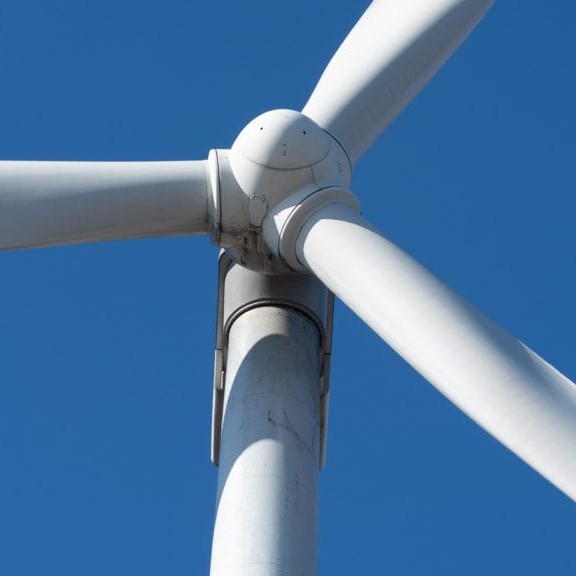 Wind power is the fastest-growing source of electricity worldwide. The American Wind Energy Association estimates that more ...
Wind power is the fastest-growing source of electricity worldwide. The American Wind Energy Association estimates that more ...
 Wind power is the fastest-growing source of electricity worldwide. The American Wind Energy Association estimates that more ...
Wind power is the fastest-growing source of electricity worldwide. The American Wind Energy Association estimates that more ...What is the Wind Energy Conversion ...
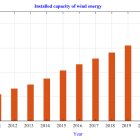 Due to technical and economic visibility, wind power has emerged as one of the most promising renewable energy sources ...
Due to technical and economic visibility, wind power has emerged as one of the most promising renewable energy sources ...
 Due to technical and economic visibility, wind power has emerged as one of the most promising renewable energy sources ...
Due to technical and economic visibility, wind power has emerged as one of the most promising renewable energy sources ...How Wind Energy is Collected and ...
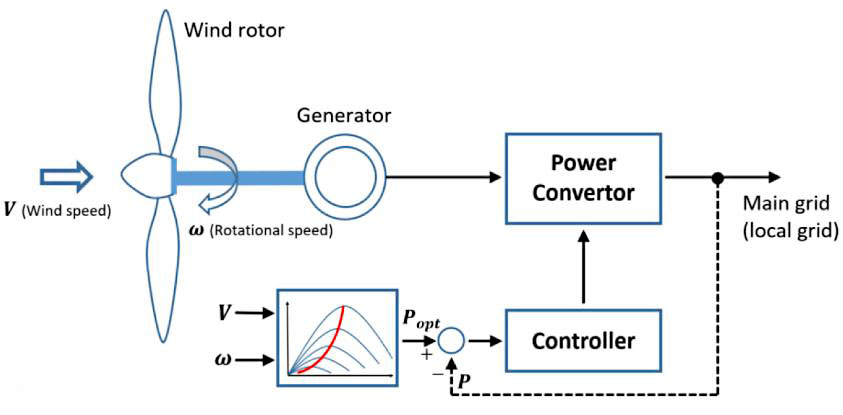 Wind energy is a form of solar energy. Earth’s atmosphere is unevenly heated by solar radiation and the air is in constant motion ...
Wind energy is a form of solar energy. Earth’s atmosphere is unevenly heated by solar radiation and the air is in constant motion ...
 Wind energy is a form of solar energy. Earth’s atmosphere is unevenly heated by solar radiation and the air is in constant motion ...
Wind energy is a form of solar energy. Earth’s atmosphere is unevenly heated by solar radiation and the air is in constant motion ...Wind Energy Background
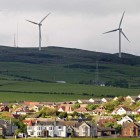 The kinetic energy in the wind is a promising source of renewable energy with significant potential in many parts of the world. ...
The kinetic energy in the wind is a promising source of renewable energy with significant potential in many parts of the world. ...
 The kinetic energy in the wind is a promising source of renewable energy with significant potential in many parts of the world. ...
The kinetic energy in the wind is a promising source of renewable energy with significant potential in many parts of the world. ...Technical Potential for Wind Energy
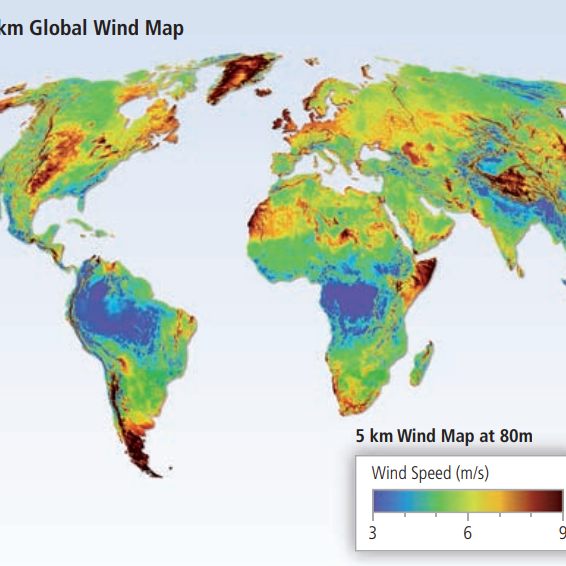 The theoretical potential for wind, as estimated by the global annual flux, has been estimated at 6,000 EJ/yr. The global ...
The theoretical potential for wind, as estimated by the global annual flux, has been estimated at 6,000 EJ/yr. The global ...
 The theoretical potential for wind, as estimated by the global annual flux, has been estimated at 6,000 EJ/yr. The global ...
The theoretical potential for wind, as estimated by the global annual flux, has been estimated at 6,000 EJ/yr. The global ...